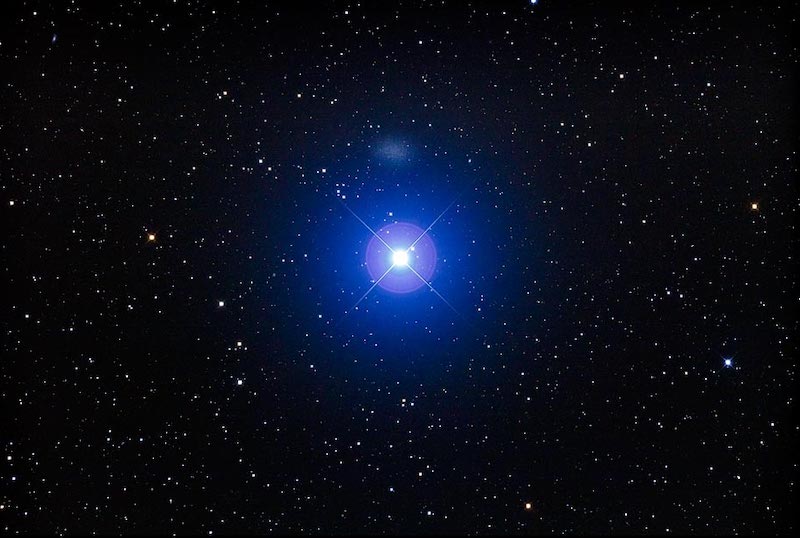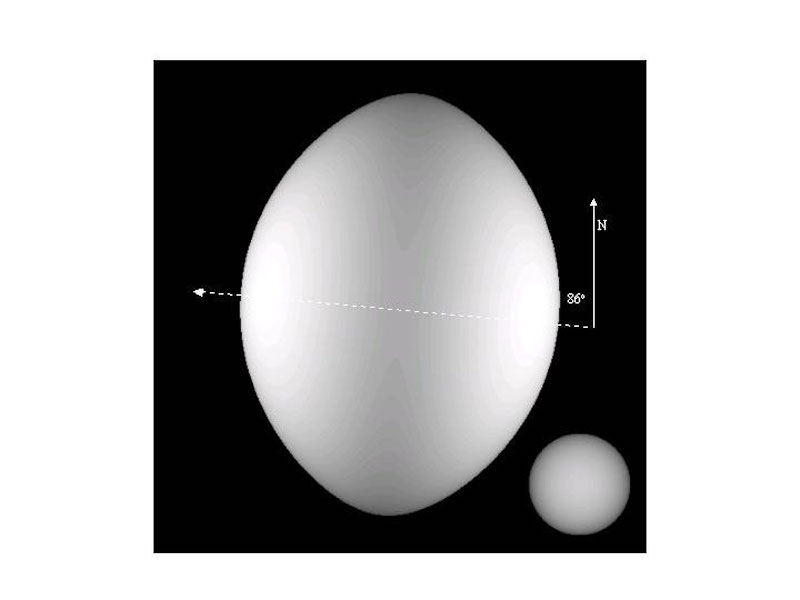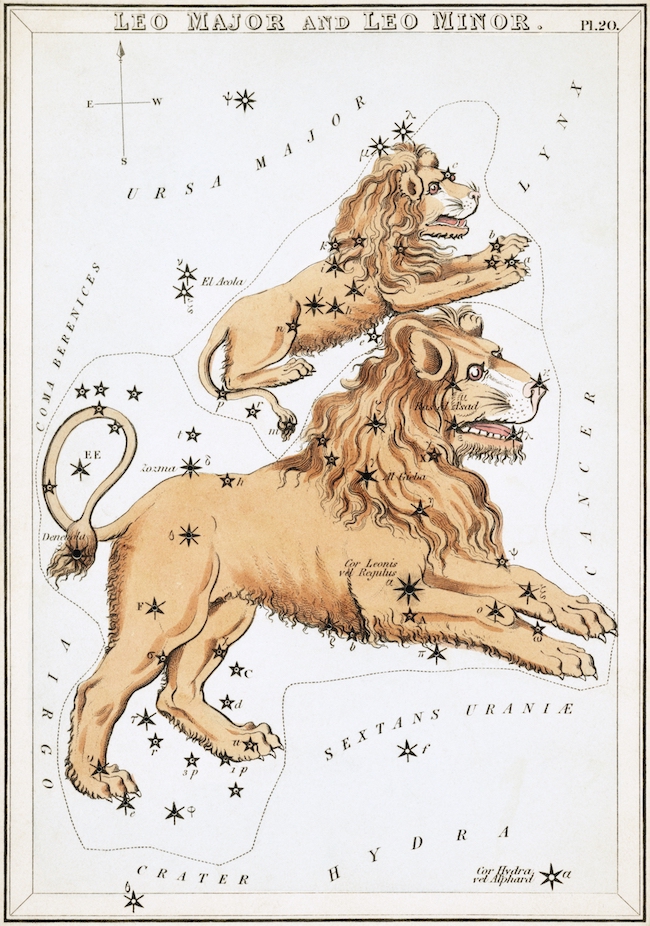

An image of Regulus obtained with a small telescope. The faint smudge above it is the dwarf galaxy Leo I. Image via Fred Espenak.
Regulus, the brightest star in the constellation Leo the Lion, is a harbinger of spring in the Northern Hemisphere. It creeps higher in the sky with each passing day in March and April as winter favorites like Orion the Hunter descend westward. By May, this brilliant blue-white star is quite conspicuous in the evening sky, as soon as the sun goes down.
On star charts, Regulus – also known as Alpha Leonis – is located at the base of a star pattern that appears like a backwards question mark. This pattern, known as The Sickle, makes up the head and forequarters of Leo the Lion. Ancient Arab stargazers called Regulus by the name Qalb al-Asad, which means Heart of the Lion. It’s also sometimes called Cor Leonis, also meaning the Lion’s Heart. This same name was said to have been given to Richard the Lionhearted (although more frequently in French).
These early astronomers would never have guessed that Regulus is actually a multiple star system with at least four component stars.

A star chart showing the constellation Leo. On the right is a pattern that looks like a flipped question mark, “the Sickle.” This is the most recognizable pattern to look for when trying to locate Leo in the sky. Image via Torsten Bronger / Wikimedia Commons.
Around February 18, Regulus is opposite the sun, rising above the horizon as the sun sets; it is up all night long, reaching its highest point due south at local midnight. By early April, Regulus is well up in the southeast an hour after sunset. By early June, it’s high in the southwest an hour after sunset. And by early July, Regulus is low to the west an hour after sunset. Regulus can be found at some time of night throughout the year except for about a month on either side of August 22, when the sun is located in Regulus’ direction in space.

During the total solar eclipse on Aug 21, 2017, Regulus was visible close to the moon during totality. It’s that little speck of light in the lower left corner. Image via Bernd Thaller/ Flickr.
Regulus is the only 1st magnitude star to sit almost squarely on the ecliptic, which marks the path of the sun, moon and planets across our sky. That means it can be seen from the entire Earth.
Bright planets sometimes pass near Regulus, and every month the moon passes no more than about 5 degrees away. In some years, the moon occults (passes in front of) this star as seen from our earthly vantage point. In fact, Regulus underwent a series of occultations – one during each month that this star was visible – starting on December 18, 2016, and concluding on April 24, 2018. There will be a series of 20 lunar occultations of Regulus, starting on July 26, 2025, and ending on December 27, 2026.
[youtube https://www.youtube.com/watch?v=qRq76tfsxHA?start=6&w=800&h=450]At about 79 light-years away, Regulus is a multiple system with at least four component stars. The main star, called Regulus A, is large and blue, with a spectral type of B8 IVn. Its surface temperature averages about 12,460 Kelvin (roughly 21,970 degrees F or 12,190 degrees C), much higher than the sun’s surface temperature of 5,778 Kelvin (9,941 °F or 5,505 °C). Regulus A is 3.8 times the mass of the sun, about three times as wide, and almost 288 times brighter.
A very rapid rotation rate of 16 hours causes Regulus A’s equatorial region to bulge, making it appear oblate – shaped like an egg – in contrast to our spherical-shaped sun, which rotates once every 25 days at its equator. If Regulus rotated just a bit faster, the star would fly apart. Regulus is not the only star known to spin so fast that it has an oblate shape. The stars Altair and Achernar are also fast spinners with flattened shapes.

A computer generated model of Regulus created in 2005 by Georgia State University’s Center for High Angular Resolution Astronomy (CHARA). A model of the sun is shown next to it for scale. The high rotation rate of Regulus creates pronounced equatorial bulging such that its diameter across its equator is one-third longer than its north-south diameter. Image via Wenjin Huang/ Georgia State University/ NSF.
Through a moderately large telescope, Regulus resolves into two objects separated by 176 arc seconds, the brighter one being Regulus A. The fainter one, Regulus B, is a cool “orange” dwarf star with a spectral classification of K2 V; it’s 0.8 times the mass of the sun, half as bright, and has a surface temperature of 4,885 Kelvin (8,333 °F or 4,612 °C).
Regulus B, meanwhile, has its own companion called Regulus C that’s only visible with powerful telescopes. This star, just 1/3 the mass of the sun, is a red dwarf star with a spectral classification of M4 V. Regulus B and C are gravitationally bound to each other; their distances ranged from 4.0 to 2.5 arc seconds between 1867 and 1943. There are no recently available measurements.
The fourth star in the system has never been directly resolved via imaging but its presence is revealed in the spectra of Regulus A. Astronomers think it may be a closely orbiting white dwarf star.
So this is not one solitary star as the eye believes, but at least four. The Regulus system is thought to be more than a billion – that’s 1,000,000,000 – years old. The system, seen from Earth as the single object, Regulus, ranks 21st in the list of brightest stars in the sky.

The larger lion is the constellation Leo, with the star Regulus at its heart, as depicted on a set of constellation cards published in London c.1825. Above it is the faint constellation Leo Minor. Image via Library of Congress/ Wikimedia Commons.
The name Regulus is from the diminutive form of the Latin rex, and means Little King. Astronomers know Regulus as Alpha Leonis, but in times past it has been known simply as Rex, as well as by kingly names in other languages. It’s not clear how Regulus went from being a king – thought to rule celestial affairs – to being a “little” king. Perhaps the thought was that Leo itself represented the King of Beasts, and there was room for one full king only.
The constellation Leo the Lion, of which Regulus is the most prominent member, is easy to visualize. As mentioned previously, Regulus dots the backwards question mark of stars that outlines the Lion’s head and mane. An easily identifiable triangle depicts the Lion’s hindquarters and tail. There is a great deal of mythology associated with Leo, perhaps the most common tale being that Leo was the Nemean Lion of the Hercules story. It is said that even in South America, some Peruvian Indians knew these stars as the Mountain Lion, whereas in China it was sometimes seen as a horse, and at other times as part of a dragon. Christians in the Middle Ages sometimes referred to it as one of Daniel’s lions.
Regulus’ position is RA: 10h 08m 22.3s, dec: +11° 58′ 02″.
Bottom line: Regulus, the brightest star in the constellation Leo the Lion, is associated with the arrival of spring, as it usually rises above the horizon in mid-February. By May, the star is very prominent in our evening sky.
Source:
https://earthsky.org/brightest-stars/best-regulus-the-heart-of-the-lion